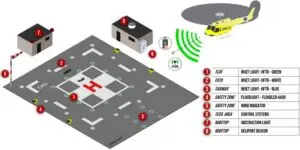In the intricate realm of aviation, every component, no matter how seemingly small, plays a pivotal role in ensuring safety and efficiency. Among these, heliport lights stand as unsung heroes, illuminating helipads and heliports worldwide, and contributing significantly to the well-being of both pilots and passengers. In this extensive guide, we will delve deeper into the myriad advantages of heliport lights, shining a brighter light on their critical role in aviation safety, and address some frequently asked questions along the way.
The Enigmatic Significance of Heliport Lights
Heliport lights are not mere bulbs that adorn landing zones for aesthetics; they are essential for several crucial reasons. Let’s embark on an in-depth exploration of their multifaceted benefits:
1. Safety Augmentation
Safety is the bedrock of aviation, and heliport lights serve as its firm foundation. These luminous sentinels provide vital visual cues for helicopter pilots, playing an integral role in ensuring safe navigation, especially during adverse weather conditions, low-light scenarios, or amidst the hustle and bustle of urban surroundings. The well-illuminated helipad acts as a beacon of safety, reducing the risk of accidents, such as misjudged landings or unfortunate collisions. Read more about Why Are LED Aircraft Warning Lights Necessary? here.
2. Nighttime Operations Unveiled
Perhaps one of the most profound benefits of heliport lights is their capacity to unlock nighttime operations. Helicopters equipped with the right lighting apparatus can take off and land at helipads around the clock, thereby bolstering the versatility and efficiency of aviation operations. This is especially crucial in medical emergencies, search and rescue missions, and other time-sensitive scenarios where the clock never stops ticking.
3. Precision Landing Precision
Landing is an art in aviation, and heliport lights provide the painter’s palette for precision. They furnish pilots with clear guidance, ensuring that helicopters descend with impeccable precision on the designated landing area. This pinpoint accuracy is particularly indispensable for heliports located in constricted urban settings, on oil rigs, or aboard ships, where every inch counts, and precision is non-negotiable.
4. The Ray of Hope in Adverse Conditions
The whims of Mother Nature, in the form of fog, rain, or snow, can spell chaos for helicopter operations. Yet, heliport lights pierce through these adverse weather conditions, providing a guiding light for pilots as they safely approach the helipad. Specific colors and intensities in these commercial lights are strategically employed to aid pilots in maintaining their orientation, irrespective of the weather’s temperament.
5. Whispering Silence: Mitigating Noise Pollution
Helicopter operations often unfold in urban environments where noise pollution is a grave concern. Heliport lights contribute to noise reduction by allowing helicopters to adhere to established flight paths and descent angles, minimizing the need for abrupt and noisy maneuvers. This reduction in noise pollution not only enhances the quality of life for the surrounding community but also respects the environment.
6. Compliance for Peace of Mind
Heliport lights aren’t merely a matter of convenience; they are a regulatory necessity. Aviation authorities worldwide, including the Federal Aviation Administration (FAA) in the United States and the International Civil Aviation Organization (ICAO) internationally, have laid down stringent guidelines and standards for heliport lighting. Compliance with these regulations is not an option but an imperative for any heliport, ensuring a safety net for all aviation activities conducted within their purview. Read more about What you need to know about LED aircraft warning lights here.
 |
An Elaborative Look at Types of Heliport Lights
Now that we have illuminated the significance of heliport lights, let us further expand our understanding by exploring the different types of lights commonly employed on helipads:
1. Approach Lighting Systems
Approach lighting systems grace the approach end of the helipad, serving as guiding stars for helicopters during their final descent. Typically arranged in a linear configuration, these lights provide a visual roadmap for pilots, aiding them in making precise and safe landings.
2. Perimeter Lighting Systems
Perimeter lights assume the role of the guardian of the helipad’s boundaries. They outline the edges of the helipad, enhancing visibility during both daytime and nighttime operations. These lights guide pilots in maintaining a safe distance from the edges, thereby diminishing the risk of ground accidents.
3. Mighty Floodlights
Floodlights, the powerful illuminators, cast their luminous net over the entire helipad. These lights are indispensable for nighttime operations, granting ground personnel a safe working environment and empowering pilots to spot any ground obstacles or hazards.
4. Wind Direction Indicators
Wind direction indicators, often in the form of windsocks, are essential instruments for pilots to gauge prevailing wind conditions during takeoff and landing. Accurate wind assessment is critical for executing a safe approach and departure.
5. Obstruction Lights
In addition to lighting the helipad itself, obstruction lights are strategically placed on nearby structures or objects that might pose a hazard to helicopter operations. These lights serve as a sentinel warning, ensuring that pilots are aware of potential obstructions, even when visibility is compromised.
 |
FAQs
Q1. Are heliport lights exclusive to airports?
No, heliport lights extend their luminous reach far beyond airport boundaries. They are equally indispensable in various settings, including hospitals, offshore oil rigs, remote exploration sites, ships, and private helipads. Any facility conducting helicopter operations can harness the safety benefits of heliport lighting.
Q2. What Significance Do Different Colors Hold in Heliport Lights?
Heliport lights wield a palette of colors, each carrying its unique significance:
Green lights: They signify the preferred approach and departure path.
Red lights: These serve as beacons, signaling obstacles or potential hazards.
White lights: These are employed for general lighting purposes.
Blue lights: Often used to delineate the helipad’s perimeter, helping pilots maintain a safe distance from the edges.
Q3. Are there Specific Regulations Governing Heliport Lighting?
Absolutely, heliport lighting is subject to stringent regulations and guidelines established by aviation authorities such as the Federal Aviation Administration (FAA) in the United States and the International Civil Aviation Organization (ICAO) on a global scale. These regulations meticulously define the requirements for heliport lighting, including light intensities, colors, and precise placement.
Q4. Can Solar-Powered Lights Illuminate Heliports?
Yes, solar-powered heliport lights are an eco-friendly and viable option, particularly in remote locations where access to electrical power is limited. They are energy-efficient and, with proper maintenance, can offer reliable performance, ensuring safety without compromising sustainability.
Q5. What Maintenance is Required for Heliport Lights?
Regular maintenance is essential to ensure the continuous functionality of heliport lights. Maintenance tasks include cleaning, bulb replacement, and rigorous testing to confirm that all lights are operating optimally. Adherence to a rigorous maintenance schedule is vital to guarantee their effectiveness.
Q6. How do Pilots Utilize Heliport Lights During Night Operations?
Pilots rely on the arrangement and colors of heliport lights as their guiding constellation during night operations. For instance, green lights signify the preferred approach path, while red lights stand as warning beacons for obstacles. Pilots decode this visual information to execute safe landings and takeoffs, even under the shroud of darkness.
Conclusion
Heliport lights are the unsung guardians of the skies, casting their luminous influence to guide helicopters safely to their destinations. Their benefits are far-reaching, from enabling 24/7 operations to ensuring precision landings and enhancing safety amidst challenging conditions. As we delve into the various types of heliport lights and their pivotal roles in aviation, one thing becomes abundantly clear: compliance with regulations and meticulous maintenance of these lights is not just a best practice; it’s an ethical obligation in the realm of aviation. Heliport lights, these beacons of safety and efficiency, continue to shine brightly as indispensable tools in the world of aviation, reminding us that in the sky, as in life, guidance and illumination are always welcome.
Buy Direct and Save $$$ – All of our lighting fixtures ship factory direct to your facility. Call sales toll-free (1-844-533-7767)
[gravityform id=”1″ title=”true” description=”true”]
